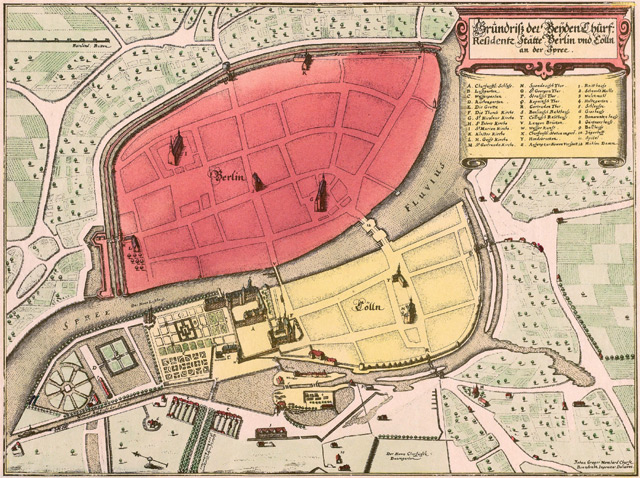Berlin was founded in 1237, but first officially documented in 1244. Around this time, merchants founded trading posts, called Berlin and Cölln, which is today Nikolaiviertel. This was a trade route between the towns of Köpenick and Spandau. For political and security reasons, the Ascanian Margrave of Brandenburg decided they should be merged into one town. By around 1400, Berlin and Cölln had approximately 8,500 inhabitants. Duke Frederick William, known as the “Great Elector”, decided to dedicate a venue to the beautification of Berlin. He laid this venue out between the City Palace and Tiergarten, and it later became known as Unter den Linden.
After the Thirty Years’ War (1618-1648), the population of Cölln and Berlin decreased to 6,000 inhabitants and a third of the houses were destroyed. The Duke wanted to promote immigration and religious tolerance, so Frederick William offered asylum to the French Huguenots. The Huguenots were persecuted in France because of their faith. In around 1700, almost 30 percent of Berlin’s inhabitants were French. Thanks to the many immigrants, the population of Berlin reached almost 20,000.
In 1701, Frederick III, Elector of Brandenburg, crowned himself King Frederick I of Prussia, which led to Berlin becoming the capital of the new Kingdom.
 |
| Map of old Berlin. Click here for full view |
Frederick II (Frederick the Great) came to power in 1740. The city then became a center of enlightenment – cultural and intellectual forces emphasized reason and individualism instead of traditional lines. In 1806, Berlin became part of the Province of Brandenburg.
Due to the Industrial Revolution in the 19th century, Berlin’s population and economy expanded enormously. It became the economic center of Germany. Suburbs of Berlin, such as Wedding, Gesundbrunnen, Charlottenburg, Tempelhof, Rixdorf, Schöneberg and Moabit grew, and the neighboring suburbs were incorporated into the city in 1861. In 1871, Berlin became the capital of the German Empire with 826,815 inhabitants, more than 105,000 of whom lived in the suburbs.
At the beginning of the 20th century, Berlin was a playground for the German Expressionists, where new artistic styles were created. Around this time, Berlin had a rapidly growing population of two million.
During, and directly after, the First World War (1914-1918), many Germans suffered from hunger. This led to massive strikes in Berlin until the end of the war. Confusion and chaos reigned in Germany. There followed a revolution in Berlin in 1918. The government was handed over to Friedrich Ebert. Philipp Scheidemann claimed the “Free German Republic”, while Karl Liebknecht claimed the “Free Socialist Republic of Germany”.
Berlin was still suffering economically years later. In 1923, Berlin reached its peak. One kilo of rye bread cost 3.6 million marks. In addition, the number of unemployed people hit its peak in 1932, with 630,000 inhabitants out of work. The streets became a dangerous and violent place where left- and right-wing groups clashed with each other.
In 1933, Adolf Hitler came to power, which led to the National Socialist takeover. Five years later, on March 12, 1938, the annexation of Austria made Berlin the capital of the “Greater German Reich”. During “Kristallnacht” (Night of Broken Glass), members of the SS and SA set fire to nine synagogues in Berlin and arrested 1,200 Jewish citizens. In 1933, around 160,000 Jews were living in Berlin, and more than 60,000 were killed in concentration camps.
 |
| Ernst Ludwig Kirchner – Brandenburger Tor |
In 1939, the Second World War started in Berlin, when war was declared on Poland. Three years later, the “Wannsee Conference” implemented measures for the “final solution to the Jewish question”. The Red Army crossed Berlin on April 21, and the Battle of Berlin began. The end of the war came on May 2, 1945. Many parts of Berlin were destroyed, including more than 600,000 apartments. The city was divided into four sections: American, British, Soviet and French.
Due to increasingly coercive measures in the German Democratic Republic (GDR), around 200,000 residents fled to West Berlin in 1960. In 1961, in June alone, more than 30,000 GDR residents fled to the west part of Berlin. This led to the beginning of construction on the Berlin Wall. On November 4, 1989, over 500,000 East Berliners gathered at Alexanderplatz to demand freedom of speech and freedom of the press. On November 9, the GDR gave in to public pressure and opened the Berlin Wall.
Soon after the fall of the Wall, government representation met to discuss the future. The German parliament moved from Bonn to Berlin in 1999. Since then, Berlin has changed enormously. Many buildings and city districts have been restored. The cultural environment has returned, and has transformed Berlin into a fascinating and artistic city. The city has an amazing multi-culturalism and is again attractive to people from all over the world. Although Berlin is bankrupt and has suffered from some scandals, the worst days are behind it.